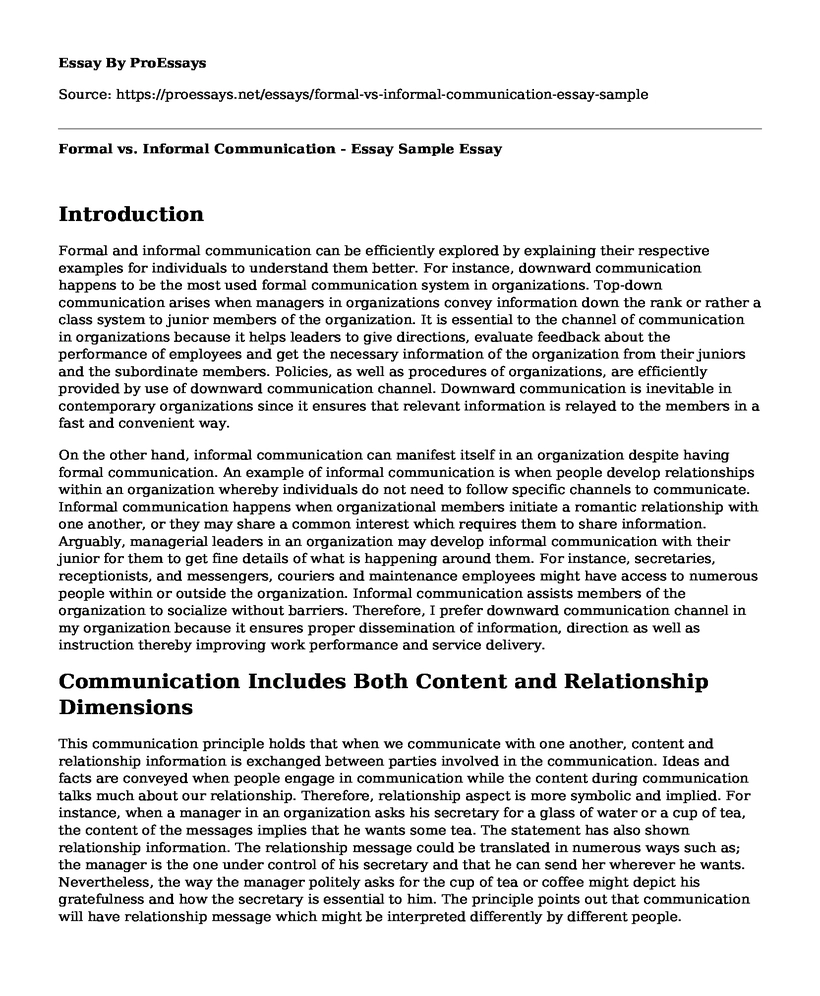Introduction
Formal and informal communication can be efficiently explored by explaining their respective examples for individuals to understand them better. For instance, downward communication happens to be the most used formal communication system in organizations. Top-down communication arises when managers in organizations convey information down the rank or rather a class system to junior members of the organization. It is essential to the channel of communication in organizations because it helps leaders to give directions, evaluate feedback about the performance of employees and get the necessary information of the organization from their juniors and the subordinate members. Policies, as well as procedures of organizations, are efficiently provided by use of downward communication channel. Downward communication is inevitable in contemporary organizations since it ensures that relevant information is relayed to the members in a fast and convenient way.
On the other hand, informal communication can manifest itself in an organization despite having formal communication. An example of informal communication is when people develop relationships within an organization whereby individuals do not need to follow specific channels to communicate. Informal communication happens when organizational members initiate a romantic relationship with one another, or they may share a common interest which requires them to share information. Arguably, managerial leaders in an organization may develop informal communication with their junior for them to get fine details of what is happening around them. For instance, secretaries, receptionists, and messengers, couriers and maintenance employees might have access to numerous people within or outside the organization. Informal communication assists members of the organization to socialize without barriers. Therefore, I prefer downward communication channel in my organization because it ensures proper dissemination of information, direction as well as instruction thereby improving work performance and service delivery.
Communication Includes Both Content and Relationship Dimensions
This communication principle holds that when we communicate with one another, content and relationship information is exchanged between parties involved in the communication. Ideas and facts are conveyed when people engage in communication while the content during communication talks much about our relationship. Therefore, relationship aspect is more symbolic and implied. For instance, when a manager in an organization asks his secretary for a glass of water or a cup of tea, the content of the messages implies that he wants some tea. The statement has also shown relationship information. The relationship message could be translated in numerous ways such as; the manager is the one under control of his secretary and that he can send her wherever he wants. Nevertheless, the way the manager politely asks for the cup of tea or coffee might depict his gratefulness and how the secretary is essential to him. The principle points out that communication will have relationship message which might be interpreted differently by different people.
The content of the communication is very crucial in our daily lives because it shows an individual's character. Content and relationship dimension in communication is essential to members of a given organization. On my side, I used to work as managing director some years back, and I used to engage my secretary in communication like sending her to fetch my documents left in my car. I could also ask her to help me arrange some confidential documents in my office. These activities showed that I was in good relationship with my secretary and that I valued her very much. I could also show gratitude to her for the accomplished work. The principle has helped contemporary people in understanding organizational communication because it has taught us how to relate with our juniors as well as subordinate staff.
References
Readings from: communication in organizations
Chapter One - Introduction to the Process of Organizational Communication
Chapter Two - Human Communication Processes and Principles
Motluk, A. (2011). A toolkit for the real world (Links to an external site.)Links to an external site New Scientist, 209, 5. Retrieved from http://www.newscientist.com/article/dn19969-a-tool-kit-for-the-real-world.html?full=true
Cite this page
Formal vs. Informal Communication - Essay Sample. (2022, Jun 19). Retrieved from https://proessays.net/essays/formal-vs-informal-communication-essay-sample
If you are the original author of this essay and no longer wish to have it published on the ProEssays website, please click below to request its removal:
- Do Single-Family Kids in High School Have Bad Performances and Lower Grades Than Nuclear-Family Kids?
- Berger's 6 STEPPS and Viral Posts Essay Example
- Essay Sample on Professional Deontology or Ethics
- Essay Sample on Adoption in the LGBT Community
- Annotated Bibliography: Matrilineal vs. Patriarchal Cultures: Gender Risk Aversion Impact
- Essay Example on 60s/70s US Domestic Politics: Protests, Activism, New Imagination
- Oppression: Systemic Discrimination and Its Impact on Society - Essay Sample







